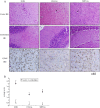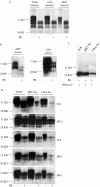Mouse-adapted scrapie strains 139A and ME7 overcome species barrier to induce experimental scrapie in hamsters and changed their pathogenic features
- PMID: 22400710
- PMCID: PMC3325885
- DOI: 10.1186/1743-422X-9-63
Mouse-adapted scrapie strains 139A and ME7 overcome species barrier to induce experimental scrapie in hamsters and changed their pathogenic features
Abstract
Background: Transmissible spongiform encephalopathy (TSE) diseases are known to be zoonotic diseases that can infect different kinds of animals. The transmissibility of TSE, like that of other infectious diseases, shows marked species barrier, either being unable to infect heterologous species or difficult to form transmission experimentally. The similarity of the amino acid sequences of PrP among species is believed to be one of the elements in controlling the transmission TSE interspecies. Other factors, such as prion strains and host's microenvironment, may also participate in the process.
Methods: Two mouse-adapted strains 139A and ME7 were cerebrally inoculated to Golden hamsters. Presences of scrapie associate fibril (SAF) and PrPSc in brains of the infected animals were tested by TEM assays and Western blots dynamically during the incubation periods. The pathogenic features of the novel prions in hamsters, including electrophoretic patterns, glycosylating profiles, immunoreactivities, proteinase K-resistances and conformational stabilities were comparatively evaluated. TSE-related neuropathological changes were assayed by histological examinations.
Results: After long incubation times, mouse-adapted agents 139A and ME7 induced experimental scrapie in hamsters, respectively, showing obvious spongiform degeneration and PrPSc deposits in brains, especially in cortex regions. SAF and PrPSc in brains were observed much earlier than the onset of clinical symptoms. The molecular characteristics of the newly-formed PrPSc in hamsters, 139A-ha and ME7-ha, were obviously distinct from the original mouse agents, however, greatly similar as that of a hamster-adapted scrapie strain 263 K. Although the incubation times and main disease signs of the hamsters of 139A-ha and ME7-ha were different, the pathogenic characteristics and neuropathological changes were highly similar.
Conclusions: This finding concludes that mouse-adapted agents 139A and ME7 change their pathogenic characteristics during the transmission to hamsters. The novel prions in hamsters' brains obtain new molecular properties with hamster-specificity.
Figures







Similar articles
-
Successive passaging of the scrapie strains, ME7-ha and 139A-ha, generated by the interspecies transmission of mouse-adapted strains into hamsters markedly shortens the incubation times, but maintains their molecular and pathological properties.Int J Mol Med. 2015 Apr;35(4):1138-46. doi: 10.3892/ijmm.2015.2102. Epub 2015 Feb 13. Int J Mol Med. 2015. PMID: 25683243
-
Protein Misfolding Cyclic Amplification Cross-Species Products of Mouse-Adapted Scrapie Strain 139A and Hamster-Adapted Scrapie Strain 263K with Brain and Muscle Tissues of Opposite Animals Generate Infectious Prions.Mol Neurobiol. 2017 Jul;54(5):3771-3782. doi: 10.1007/s12035-016-9945-8. Epub 2016 Jun 4. Mol Neurobiol. 2017. PMID: 27259989
-
Re-transmissibility of mouse-adapted ME7 scrapie strain to ovine PrP transgenic mice.J Vet Sci. 2019 Mar;20(2):e8. doi: 10.4142/jvs.2019.20.e8. Epub 2019 Mar 12. J Vet Sci. 2019. PMID: 30944531 Free PMC article.
-
Prion encephalopathies of animals and humans.Dev Biol Stand. 1993;80:31-44. Dev Biol Stand. 1993. PMID: 8270114 Review.
-
Insights into Mechanisms of Transmission and Pathogenesis from Transgenic Mouse Models of Prion Diseases.Methods Mol Biol. 2017;1658:219-252. doi: 10.1007/978-1-4939-7244-9_16. Methods Mol Biol. 2017. PMID: 28861793 Free PMC article. Review.
Cited by
-
Scrapie infection in experimental rodents and SMB-S15 cells decreased the brain endogenous levels and activities of Sirt1.J Mol Neurosci. 2015 Apr;55(4):1022-30. doi: 10.1007/s12031-014-0459-4. Epub 2014 Nov 13. J Mol Neurosci. 2015. PMID: 25391763
-
MiRNA expression profiles in the brains of mice infected with scrapie agents 139A, ME7 and S15.Emerg Microbes Infect. 2016 Nov 9;5(11):e115. doi: 10.1038/emi.2016.120. Emerg Microbes Infect. 2016. PMID: 27826142 Free PMC article.
-
PrP octarepeats region determined the interaction with caveolin-1 and phosphorylation of caveolin-1 and Fyn.Med Microbiol Immunol. 2013 Jun;202(3):215-27. doi: 10.1007/s00430-012-0284-8. Epub 2013 Jan 3. Med Microbiol Immunol. 2013. PMID: 23283514
-
Disruption of glycosylation enhances ubiquitin-mediated proteasomal degradation of Shadoo in Scrapie-infected rodents and cultured cells.Mol Neurobiol. 2014 Jun;49(3):1373-84. doi: 10.1007/s12035-013-8612-6. Epub 2014 Jan 4. Mol Neurobiol. 2014. PMID: 24390475
-
Aberrant Alterations of Mitochondrial Factors Drp1 and Opa1 in the Brains of Scrapie Experiment Rodents.J Mol Neurosci. 2017 Mar;61(3):368-378. doi: 10.1007/s12031-016-0866-9. Epub 2016 Dec 6. J Mol Neurosci. 2017. PMID: 27921253
References
Publication types
MeSH terms
Substances
LinkOut - more resources
Full Text Sources
Research Materials

